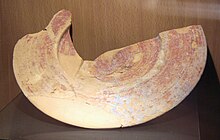Mogador (island)
| Mogador | ||
|---|---|---|
| Mogador Island as seen from Essaouira Beach | ||
| Waters | Atlantic | |
| Archipelago | Iles Purpuraires | |
| Geographical location | 31 ° 29 '44 " N , 9 ° 47' 11" W | |
|
|
||
| length | 790 m | |
| width | 620 m | |
| surface | 30 ha | |
| Map of the island of Mogador (top left) in Essaouira Bay , by Théodore Cornut, 1767. | ||
The island of Mogador ( French Île de Mogador , Arabic جزيرة موغادور) is the main island of the Iles Purpuraires near the city of Essaouira in Morocco . It is about 3 kilometers long and 1.5 kilometers wide and is about 1.5 kilometers from Essaouira.
history

The Carthaginian navigator Hanno visited the island in the 5th century BC and founded a trading post. Archaeological finds from the Phoenician period have been made on the island .
Towards the end of the first century before or at the beginning of the first century after Christ, purple was mined on the island by order of the Mauritanian king Juba II .
Roman traders settled the island during the reign of Emperor Augustus . The foundations of a Roman house as well as coins and other artifacts have been found on the island. Mogador and the other Iles Purpuraires were connected to the province of Mauretania Tingitana by merchant ships in the first and second centuries AD . From the first to the fourth century AD, the island with the Roman province of Mauretania Tingitana was connected to the Roman Sala Colonia by regular shipping.
In August 1844, the French Navy besieged and captured the island as part of the Franco-Moroccan War.
The island is now designated as a nature reserve and may only be visited with official permission.
Flora and fauna
An investigation in 2014 showed that Eleonora's falcons ( Falco eleonorae ) hunt on the island and hide their prey, some of which are still alive. Abdeljebbar Qninba from the Mohammed V University in Rabat and his colleagues found small birds with missing flight and tail feathers in small caves or holes. It is believed that the feathers were either plucked by the falcons or that they were prey that had escaped.
Web links
- L'île de Mogador mogador-essaouira.com
Individual evidence
- ^ A b Edward Lipiński: Itineraria Phenicia . Peeters Publishers, 2004, ISBN 90-429-1344-4 , pp. 466 ( books.google.com ).
- ^ Martijn Theodoor Houtsma: EJ Brill's First Encyclopaedia of Islam 1913-1936 . tape 9 . Brill, 1987, ISBN 90-04-08265-4 , pp. 550 ( books.google.com ).
- ↑ Falcons imprison birds to eat later . In: New Scientist . 229, No. 3055, January 9, 2016.


